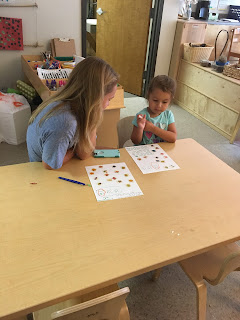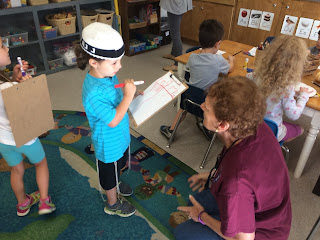It's been a great week in the Tzemach class! We've been doing some serious otter exploring and I've been so impressed with how much the kids have learned. The kids seem to be ready to move on to another topic. I will talk to them about it again next week to make sure that's their decision. If it is, then we'll move on to another exploration of their choice. If not, then we'll enjoy learning more about otters.
To start our week, we learned about a young otter pup that was rescued off the coast of Washington. One of our parents found out about him and sent me the link. The kids have been fascinated by him! We did some research and learned that his name is Rialto and that he was found abandoned on the coast. He was rescued and taken to a vet where they learned that he was suffering from pneumonia and gastrointestinal issues. They were able to treat him and place him in the care of the Vancouver Zoo. At the zoo, they are caring for him and helping to rehabilitate him. They have also set up webcams so that he can be watched online. This has been awesome for us to watch him play! We've witnessed him be being bottle fed, playing with toys in a crib made of pvc pipe and net, and watched him swim in a small pool. As we've watched him, we've learned that since he's a sea otter his paws are webbed. From reading our books, we learned that this isn't the case for all otters. We've been able to watch how he swims, plays and eats. We kept this webcam up on our computer during each day this week. It was sweet to watch the kids check on him. We even noticed this expanding into their play as they made safe pools and cribs for baby otters with our wooden blocks. Here is a link to the webcam if you'd like to follow him along with us...http://www.vanaqua.org/learn/see-and-learn/live-cams/baby-otter .
Lately, the kids have loved doing surveys in the classroom! We've been learning how to draw columns, each titled with either a "yes" or "no". We noticed that most of these surveys lately have been focused on otters. Since we've learned so many facts, we were curious so see how much others already knew about otters. We gave the option to the kids to walk the preschool hall and ask otter survey questions to the different classes. Not all of them wanted to, but everyone wanted to go on the walk. Those that did ask questions, went to several classrooms asking their question and then marking it on their clipboard. When we came back to the room, we talked about the different answers that we received. We learned from this experience that we've become some pretty great otter experts! This was a great way for us to express what we knew about otters and for us to mingle with the other classrooms. We were even able to teach them some facts along the way!
This study of otters has really gotten the kids interested in non fiction books. We've been doing a lot of comparing and contrasting fiction and non fiction books. As we've studied these, we've also talked about the jobs of an author, illustrator, and the publishing company (which we learned will always be listed on the title page). All of this led us to writing some of our own books. We thought it would be fun to make a big class non fiction books about otters. The kids thought this would be a great way to show other people everything that we've learned about otters!
To start our book, each child told us their favorite fact about otters that they've learned so far. After discussing this fact with us, they drew a picture on their page that went along with their fact. As we explored our books, we realized that the pictures always match the words on the page. We were careful to do the same as we wrote our book so that others could use our pictures as clues as to what the page was about. Some of the kids chose to put words on their page, others only wanted to draw. We did not set any limits to their work so each page is done however the child felt like creating it. Michelle and I wrote down their facts and printed them so that they could be glued to each page.
The following day, we learned about editors and publishers. We did some editing and publishing of our own! We let each child sit down with their page a second time. We asked them if there was anymore details they'd like to add or any edits they wanted to make. Once they finished their editing, we read them the fact that they told us the previous day and asked them to put it in a pile based on the theme. During our morning meeting that day, the kids agreed that our books should have similar topics placed together. So, anyone with a fact about food, put their page in the food pile. Anyone with a baby fact, put their page in the baby pile. We went through this process with each child and worked together to figure out the best layout for our book. Once the kids had it the way they wanted it, several of them worked together to make a front cover. We then laminated the book and bound it together. We hope you love our first book! It will on display in our science center with our other non fiction books. We've learned so much from this exploration, and we hope you did too!
Love,
Ms. Rachael
Approaches to Learning:
- Show creativity and imagination using materials in representational play.
- Demonstrate eagerness and interest as a learner by questions and adding ideas.
- Demonstrate growing initiative in selecting and carrying out activities.
- Demonstrate growing ability to predict possible outcomes based on prior experiences and knowledge.
Social & Emotional:
- Demonstrate self direction by making choices among peers, activities and materials.
- Respond respectfully to positive and negative feedback from adults most of the time.
- Manage transitions positively when told what to expect.
- Interact easily with familiar adults by engaging in conversations, responding to questions and following direction.
Language & Literacy:
- Show interest in informational texts about familiar objects.
- Incorporate favorite parts of literary texts into play activities.
- begin to ask questions about the causes of events they observe or hear about in books.
- Begin asking "how and why" questions when looking at texts.
- Use drawings, letters, or words to create narratives about people and things in their environment.
- Begin to use classroom resources such as books, charts, photographs and graphs to gain information about topics of interest.
Mathematics:
- Generate conjectures based on personal experiences and simple reasoning.
- Investigate solutions to simple problems.
- Begin to show an awareness of numbers in the environment.
- Represent simple joining and separating situations through 4.
- Associate at least two measurement devices with their purpose.
Keeping a close eye on Rialto...
Fun with our math buddies!...
Writing, illustrating, and editing our class book...
Surveying the school about otters...
Our finished book! In case you didn't get to see it in the hall today...





























































